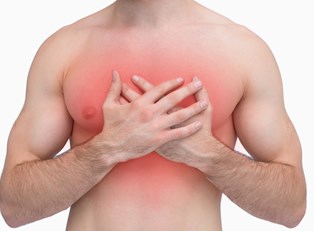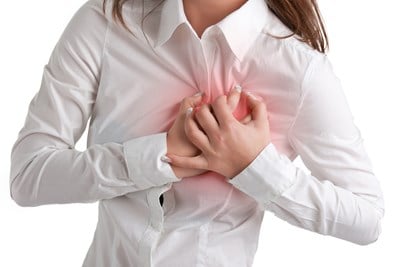Chest pain can occur suddenly at any time and without warning. One may try to ignore it at first, but chest pain can be scary and worrisome. Most people don't know what a heart attack feels like or if they should go to the emergency room.
Chest pain is one of the most common reasons people call for emergency medical help. Every year, ER (emergency room) doctors evaluate and treat millions of people for chest pain. Fortunately, chest pain doesn't always signal a heart attack. Most often, chest pain is unrelated to the heart. But even if the chest pain has nothing to do with the cardiovascular system, what is causing it may still be important and worth the time seeking medical help for evaluation. In general, a chest pain related to a heart attack or other heart problem is associated with one or more of these symptoms: pressure, fullness or tightness in the chest; crushing or searing chest pain that radiates to the back, neck, jaw, shoulders and arms, especially the left arm; pain that lasts more than a few minutes, goes away and comes back or varies in intensity; shortness of breath, sweating, dizziness or nausea.
What Causes Chest Pain?
A wide range of health problems can cause chest pain, all of which deserve medical attention. Several issues relating to the heart can cause chest pain. A heart attack is the result of a blood clot blocking blood flow to the heart muscle. Angina occurs when hard, thick cholesterol-containing plaques that gradually build up on the inner walls of the arteries, narrow the arteries, and restrict the heart's blood supply. Aortic dissections is a life-threatening condition involving the aorta (the main artery leading from the heart). This can result from a sharp blow to the chest or as a complication of uncontrolled high blood pressure. In coronary spasm (Prinzmetal's angina) arteries that supply blood to the heart go into spasm, temporarily stopping blood flow, causing chest pain. Pericaditis is an inflammation of the sac surrounding the heart and is often related to a viral infection. Other causes of chest pain can be related to the digestive system, musculoskeletal system, and respiratory system. Heartburn, esophageal spasm, hiatal hernia, achalasia (swallowing disorder), and gallbladder or pancreas problems can cause chest and abdominal pain. Other chest pain causes include pleurisy, panic attack, shingles (rash infection) and rarely cancer.
Risk Factors of Chest Pain Causes
The risk factors of chest pain include being over fifty years of age, living with AIDS, cancer, chest injury (broken/bruised rib, puncture wound), COPD (chronic obstructive pulmonary disease), deep venous thrombosis (blood clot of the vein), diabetes, elevated cholesterol, emphysema, heart disease, high fat diet, hypertension (high blood pressure), obesity, pulmonary embolism (blood clot of the lung), severe asthma and a smoking habit. A family history of heart disease also greatly increases the risk of chest pain. Habits and lifestyle choices may be a risk, such as perpetuating an imbalanced diet rich in fats and cholesterol, which contributes to the possibility of an unhealthy weight. Smoking tobacco and consuming more than one or two alcoholic beverages per day greatly increases the risk of chest pain. Living and working in a high stress environment, in extreme temperatures, and/or under strenuous circumstances all increase the risk of chest pain. Lack of exercise and physical activity contributes to many of the risk factors of chest pain (obesity, high blood pressure, high cholesterol) and only compounds those risks as they become less and less controlled.



